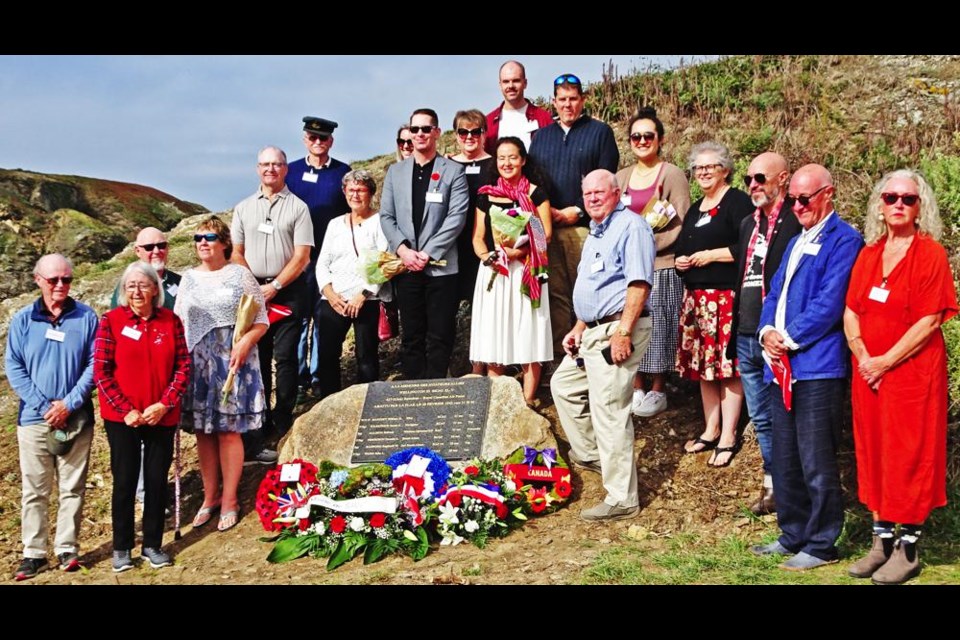WEYBURN – On the last night of February of 1943 over the town of Saint-Nazaire, on the Brittany coast of northwestern France, a Wellington bomber carried out a mission to bomb a Nazi submarine base, and the plane went down with five of the six crewmen killed, including F/Sgt. Donald Ferguson of Weyburn.
Eighty years after that plane crash, on Belle-Ile-En-Mer off the Brittany coast, 12 members of Ferguson’s family gathered on Sept. 30 for the unveiling ceremony of two markers commemorating that air crew, along with several relatives of the other crew members.
For F/Sgt. Ferguson’s family, they did not learn what happened to him until three years after the mission, because as it turned out, he fell out of the plane without a parachute into the ocean, and his body was never recovered. Four of the crew were on the plane when it crashed on the island, and one man parachuted out and was a prisoner-of-war until he was liberated in April of 1945.
The Wellington was part of a huge bombing raid launched by the RAF Bomber Command on Feb. 28, 1943, to take out the sub base, with a total of 437 aircraft that included 152 Lancasters, 119 Wellingtons, 100 Halifaxes, 62 Stirlings and four Mosquitos, carrying a total of around 2,900 airmen.
The plane F/Sgt. Ferguson served as a bomb aimer on was the Wellington III BK343 ZL-V, and they flew as part of the 427 (Lion) Squadron of the RCAF. They dropped their bombs from 16,500 feet, or 5,000 metres, and was hit by anti-aircraft flak from a German battery at Saint-Nazaire that damaged an engine, causing it to catch on fire.
The plane then immediately headed west over the water, and Ferguson and wireless operator Sgt. Edward Allison opened the forward escape hatch to throw heavy items out of the plane so it could maintain altitude. The plane was then lit up by searchlights on Belle-Ile and was hit again by flak.
In an effort to avoid the flak, the pilot had turned the plane towards the side with the damaged engine and it went into a bit of a dive, which threw Ferguson off-balance, and he fell out of the escape hatch into the ocean.
Sgt. Allison then put on a parachute and jumped out, and shortly afterward the plane crashed into the rocks on the western side of the island, killing the remaining four crewmen.
Allison was later able to supply much of the information about how Ferguson had died, in a memoir he wrote in later years. Allison said he informed the Germans who captured him that Ferguson had fallen out of the plane, and the Germans made a search but were unable to find his body.
As Allison was a POW, the air force did not learn these details until nearly three years after the crash, when Ferguson’s family in Weyburn were finally able to learn he had been killed and was not just missing.
The Germans buried the bodies of the four crewmen, including the pilot, W/O William Hartney, navigator F/Sgt. James Kilpatrick, rear gunner F/Sgt. John Ward, and observer Sgt. Reginald Radford, on his first mission. The bodies were relocated in 1948 to the Commonwealth Cemetery at Pornic on the mainland.
Sgt. Allison died in January of 2002 at the age of 81, and his ashes were spread over the graves of the four air crew.
Ken Ferguson of Weyburn, a nephew of the airman, was contacted in 2020 by René Brideau, a resident and historian of the area who did research on the plane that went down, and had been able to contact the families of most of the crew members.
Through Brideau’s efforts, the mayor of Sauzon, a town on the island near where the plane went down, helped to get two memorial markers in place, and the markers were unveiled on Sept. 30 with as many relatives of the crew who were able to come. One, including a full account of the plane’s flight in French and English, is located on the road near Sauzon, and the other was near the rocky beach where the plane went down.
Ken, along with 11 other Ferguson family members, was able to be present to help unveil the marker, and said there was a crowd of about 200 to 250 on hand for the ceremony, which included a band that played the national anthems of Canada, England and France.
He praised the hard work of the French government and volunteers like Brideau, who put in a lot of research not only to find out what happened to the plane, but to contact the family members of all the crew. The Fergusons were the last family to be contacted about attending the unveiling of the memorial marker.
“The French truly are very passionate about giving credit to the Canadians and the other countries that fought to free France from the Nazi regime,” said Ferguson. “There was an awful lot of work put in to make this whole thing happen.”
He and wife Pat are from Weyburn, where Ken’s grandfather and his father came to homestead in 1908. The other relatives who attended the memorial unveiling came from B.C., Alberta and Ontario.






